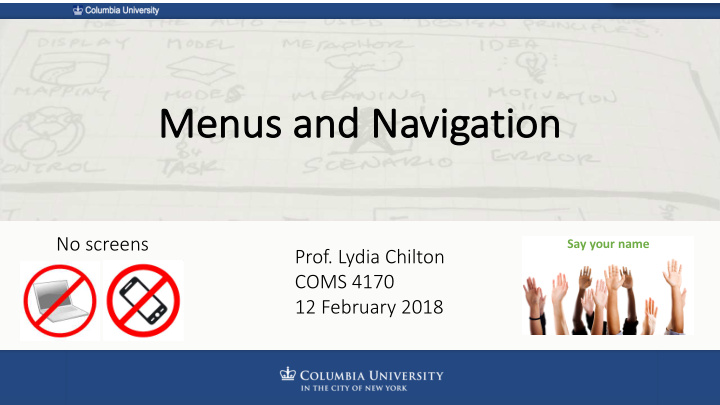



Me Menus nus and nd Navigation No screens Say your name Prof. Lydia Chilton COMS 4170 12 February 2018
Users can’t focus on everything at once. They have a spotlight of attention. 1 2 3 The design must guide users’ attention .
Visual Hierarchy: Conceptual Grouping You are cordially invited to Robert You are cordially invited to and Alexandra’s delectable after Robert and Alexandra’s delectable after dinner dinner party. Wine and nibbles will party. be served. When: February 20 th , Wine and nibbles will be served. 2018 at 9:30pm. Where: the pad. If you need directions, ping us. Kindly When: February 20 th , 2018 at 9:30pm. let us know if you will be attending Where: the pad. If you need directions, ping us. by February 1 st . Kindly let us know if you will be attending by February 1 st .
Eye Tracking Data
But for complex tasks, the information doesn’t fit in one screen. Buying a book on Amazon : • Search for the book • Select the edition • See the reviews • Look at the index • How many pages does it have? • Put it in your cart • Shop around for other things • Select a payment method • Enter payment method information • Enter shipping information • Go back and put something else in the cart • Change to rush delivery • Remove something from the cart
For complex tasks, guide users attention by breaking the task into states, options, and transition to new states.
Examples of States, Options and Transitions
n: What is this state? Am Amazon: Am Amazon : What are the options in this state?
n: What are the options in this state? Am Amazon:
n: What are the options in this state? Am Amazon:
n: What are the options in this state? Am Amazon:
n: What are the options in this state? Am Amazon: Bob Ross 1234123412341234 1234
n: What are the options in this state? Am Amazon:
n: Why are we in this state? Am Amazon:
er: What is this state? Ub Uber Ub Uber er : What are the options in this state?
er : What are the options in this state? Ub Uber
er : What are the options in this state? Ub Uber
What are the states, options, and transitions of MS Word ? cha hang nging ng the he font in n MS
Ch Change font : What state are we in? Change font : What are the options in this state? Ch
Ch Change font : What are the options in this state?
Ch Change font : What are the options in this state?
DDR DDR : What state are we in? DDR DDR : What are the options in this state?
DDR DDR : What are the options in this state?
DDR DDR : What are the options in this state?
DDR: Why are we in song selection mode?
When you have too much information for one screen, ns for the user to de desig ign n states, optio tions ns and and tr trans ansitio itions navigate through to complete their goal.
In a state, how many options are there?
Am Amazon n se search : How many options are there?
s: How many options are there? Am Amazon n Resul sults:
partments : How many options are Am Amazon n Depa there?
~10 options, how do you display When displaying ~10 them to suit the needs and abilities of people? List
~100 options, how do you display When displaying ~100 them to suit the needs and abilities of people? A tree
~1000 options, how do you display When displaying ~1000 them to suit the needs and abilities of people? Search
Ya Yahoo 1995: What interaction style is this?
Bo Books s 1200: 1200: What interaction style is this?
1000 items
When displaying options, the number of options determines the interaction style. ~10 items = list ~100 items = tree ~1000 items = search
Designing Menu Options
What happens when you have too many options?
Why is this first?
Why is this 10 menu items deep?
Pe People have limited time. Make frequently used options easier to access Make rarely used options harder to access
What happens when there are ir irrele elevan ant options?
TITANIUM WHITE
CADMIUM YELLOW
SAP GREEN
PHTHALO BLUE
Why not do this? ELECTRIC PINK
Irrelevant options create distractions Users will expend energy to focus. OR make mistakes
ly Mode : Gm Gmail ail Reply What options/information is at hand?
ace : Gm Gmail ail Compose Interface What options are hand?
Summary
Users can’t focus on everything at once. They have a spotlight of attention. 1 2 3 The design must guide users’ attention .
For complex tasks, guide users attention by breaking the task into: states, options, and transitions to new states. st
When displaying options, the number of options determines the interaction style. ~10 items = list ~100 items = tree ~1000 items = search
Pe People have limited time. Make frequently used options easier to access Make rarely used options harder to access
cus . People have limited focu Within a state, provide options that are relevant to the user completing their goal. NO YES
Recommend
More recommend